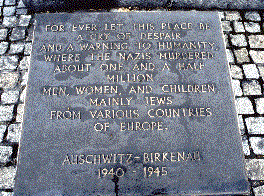‘The simplest valid reason for being skeptical about the extermination claim is also the simplest conceivable reason: at the end of the war they were still there.’
Conclusions. Ginsburg and HimmlerProf. Arthur Butz |
Plaques at Auschwitz | ||

| |||
| Before: Four Million | |||

| |||
| After: One and a half Million |
A study such as the present one necessarily labors under severe handicaps regarding relevant statistics. Indeed, I was surprised that it was possible to reconstruct statistical and quantitative aspects even to the incomplete extent presented here. The most powerful groups on earth have sought to distort the record of what actually happened to the Jews of Europe during the Second World War.
J. G. Burg
In his memoirs, J. G. Burg (Josef Ginsburg) has presented a story completely consistent with the historical record. At the outbreak of war in September 1939, he was resident in Lemberg, Poland. He immediately fled with his family to Czernowitz, Romania, in the province of Bukovina, which the Red Army occupied in June 1940. A year later, the German attack on Russia drove out the Red Army, and Ukrainian bands started conducting pogroms, which were halted by German and Romanian troops. Later, Ginsburg and his family were deported east to Transnistria, where life was at least bearable. A Mr. Kolb of the Swiss and International Red Cross visited their settlement in early 1943.
After the German defeats mounted, there was growing tension between the Germans and Romanians, and many Romanians attempted to befriend the Jews. The German-Romanian front started to collapse in mid-1944, and Ginsburg and family returned to Czernowitz. Everywhere there was chaos, starvation, and the Russian terror. Even after the end of the war, conditions were not very good, so in 1946, Ginsburg and family moved on to Breslau and then proceeded to an UNRRA DP camp near Munich in the U.S. occupation zone of Germany. In the camp, almost all Jews were naturally very interested in the possibility of proceeding to the U.S., because they knew that many Jews were doing just that. However, the Zionist leadership attempted by all means to divert their interest from the U.S. to Palestine. To the question “Can one emigrate to the U.S. and remain a Zionist?” a Professor Spiktor replied:
Whoever emigrates to the US in this hour of destiny, can not only be no Zionist, he also thereby forsakes his own Jewish people.
Six months later, Professor Spiktor emigrated to the U.S. Ginsburg and his family went to Palestine with many of the other Jews from the camp.
Conclusions
We are now very close to the end of our study. The thesis of this book has been proved conclusively. The Jews of Europe were not exterminated, and there was no German attempt to exterminate them. The Germans resettled a certain number, and these people were ultimately resettled again in accordance with Allied programs. Although various statistical details are missing from our analysis, it is possible to reconstruct quantitative aspects of the problem to a satisfactory degree.
The Jews of Europe suffered during the war by being deported to the East, by having had much of their property confiscated, and, more importantly, by suffering cruelty in the circumstances surrounding Germany’s defeat. They may even have lost a million dead.
Everybody in Europe suffered during the war, especially the people of central and eastern Europe. The people who suffered most were the losers, the Germans (and Austrians), who lost 10 million dead due to military casualties, Allied bombings, the Russian terror at the end of the war, Russian and French labor conscriptions of POW’s after the war, Polish and other expulsions from their homelands, under the most brutal conditions, and the vengeful occupation policies of 1945-1948.421
Himmler Nailed it Perfectly
The “gas chambers” were wartime propaganda fantasies completely comparable to the garbage that was shoveled out by Lord Bryce and associates in World War I. The factual basis for these ridiculous charges was nailed with perfect accuracy by Heinrich Hiimmler in an interview with a representative of the World Jewish Congress just a few weeks before the end of the war:422
in order to put a stop to the epidemics, we were forced to burn the bodies of incalculable numbers of people who had been destroyed by disease. We were therefore forced to build crematoria, and on this account they are knotting a noose for us.
It is most unfortunate that Himmler was a “suicide” while in British captivity, because had he been a defendant at the IMT, his situation would have been such that he would have told the true story (being fully informed and not in a position to shift responsibility to somebody else), and books such as the present book would not be necessary, because the major material could be read in the IMT trial manuscript. But then, you see, it was not within the bounds of political possibility that Himmler live to talk at the IMT.
That Himmler’s assessment of the gas chamber accusations is the accurate one should be perfectly obvious to anybody who spends any time with this subject, as we have seen especially in Chapter 4. In particular, Hilberg and Reitlinger should have been able to see this before completing even fractions of their thick books, which are monumental foolishness.
421. Aretz, 337-346.
422. Reitlinger, 521.
Arthur R. Butz, The Hoax of the Twentieth Century, Castle Hill Publishers, 2003, pp. 286-288, first published by Historical Review Press, 1976.